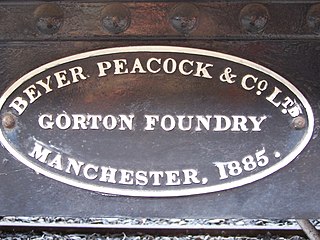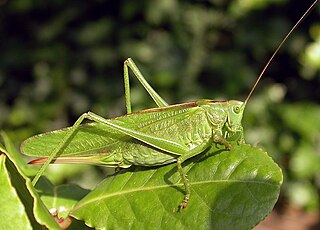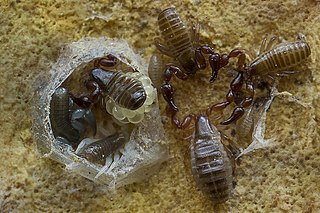
Beyer, Peacock and Company was an English general engineering company and railway locomotive manufacturer with a factory in Openshaw, Manchester. Charles Beyer, Richard Peacock and Henry Robertson founded the company in 1854. The company closed its railway operations in the early 1960s. It retained its stock market listing until 1976, when it was bought and absorbed by National Chemical Industries of Saudi Arabia.

Periplaneta is a genus of cockroaches containing some of the well-known pest species with cosmopolitan distributions, such as:

The Tettigoniinae are a subfamily of bush crickets or katydids, which contains hundreds of species in about twelve tribes.

Chernetidae is a family of pseudoscorpions, first described by Anton Menge in 1855.
Nesidiochernes is a genus of pseudoscorpions in the Chernetidae family. It was described in 1957 by Austrian arachnologist Max Beier.
Synsphyronus is a genus of pseudoscorpions in the Garypidae family. It was described in 1930 by American arachnologist Joseph Conrad Chamberlin. Its distribution is mainly in Australia, but also extends to New Zealand and New Caledonia.
Cordylochernes is a genus of pseudoscorpions in the Chernetidae family. It was described in 1932 by Austrian arachnologist Max Beier.

Withiidae is a family of pseudoscorpions, first described by Joseph Conrad Chamberlin in 1931.
Austrochernes is a genus of pseudoscorpions in the subfamily Chernetinae, first described by Max Beier in 1932. Species of this genus are found in mainland Australia and New Guinea. The Australian Faunal Directory decisions for synonymy are based on a 2018 paper by Mark Harvey.

Paratemnoides is a genus of pseudoscorpions in the Atemnidae family. It was described in 1991 by Australian arachnologist Mark Harvey.
Austrochernes dewae is a species of pseudoscorpion in the Chernetidae family. It is endemic to Australia. It was described in 1967 by Austrian arachnologist Max Beier.
Haplochernes is a genus of pseudoscorpions in the Chernetidae family. It was described in 1932 by Austrian arachnologist Max Beier.
Nesidiochernes is a monotypic genus of pseudoscorpions in the Chernetidae family. It is native to Oceania, and was described in 1932 by Austrian arachnologist Max Beier.
Sundochernes queenslandicus is a species of pseudoscorpion in the Chernetidae family. It is endemic to Australia. It was described in 1975 by Austrian arachnologist Max Beier.
Calymmachernes is a monotypic genus of pseudoscorpions in the Chernetidae family. It is endemic to Australia. It was described in 1954 by Austrian arachnologist Max Beier.

Conicochernes is a genus of pseudoscorpions in the Chernetidae family. It is endemic to Australia. It was described in 1948 by Austrian arachnologist Max Beier.
Megachernes is a genus of pseudoscorpions in the Chernetidae family. It was described in 1932 by Austrian arachnologist Max Beier.

Withius is a genus of pseudoscorpions in the Withiidae family. It was described in 1911 by English zoologist Harry Wallis Kew. The generic name Withius honours Danish arachnologist Carl Johannes With (1877–1923).
Afrosternophorus is a genus of pseudoscorpions in the Sternophoridae family. It was described in 1967 by Austrian arachnologist Max Beier.
Protogarypinus is a genus of pseudoscorpions in the Garypinidae family. It is endemic to Australia. It was described in 1954 by Austrian arachnologist Max Beier.






